
Map of the Botanical Garden.
Click here to enlarge in a new window.
|
North of the main trail from the entrance steppe plants from the East Mediterranean region and Middle Asia are grown.
This area is especially beautiful during the spring when many plants commence to flower. On the other side American and Asian plants
were planted and contrast the steppe plants due to their later flowering period.
|
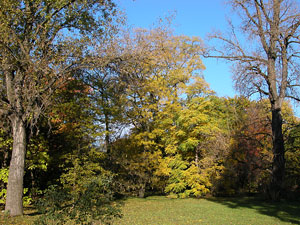
View into the autumnal arboretum.
|
The arboretum is systematically arranged and comprises many different
species. Remarkable are very old trees of e.g. Sophora japonica, Juglans nigra, Gymnocladus dioicus,
Metasequoia glyptostroboides, and Acer campestre. In the driest part of the Botanical Garden close to the observatory many gymnosperms are planted.
In the 'forest' grow many spring ephemerals as well as plants from 'primitive' plant families.
|
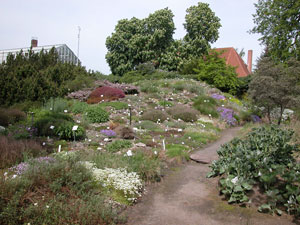
View to the alpinum. In the background the Laurentius church.
|
The alpinum with many high
mountain plants surrounds a small plant bed with beach and sand dune plants.
|
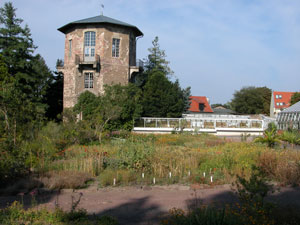
The ephemeral group in front of the observatory.
|
Many annual plants are grown in front of the observatory
(ephemeral group). This area is particularly beautiful coloured during the late spring and early summer. On the 'Neuwerkhang'
many shrubs and other plants from Asia are cultivated. Particularly interesting among them is the collection of Cotoneaster and
Berberis. This area is exposed to the south and dry and hot. Nevertheless, it is nicely arranged and appears sometimes like a labyrinth.
The tall forb community keeps many herbaceous plants growing up to 3 or 4 meters high. These plants are from the monsoonal east
sides of the continents.
The Mediterranean slope community grows on limestone gravel and consists of rather hardy plants from
southern Europe.
|

The systematic section.
|
The plants in the systematic section are arranged according to their systematic relationship. It is a traditional
arrangement according to the 'System der natürlichen Pflanzenfamilien' of A. Engler. The forest steppe is named because
many plants from the transition zone between forests and steppes in Eastern Europe are growing there.
|
The Greenhouses
|
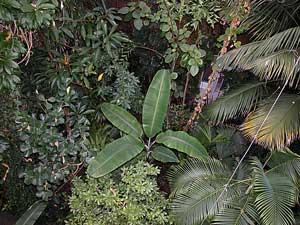
View from top into the tropical greenhouse.
|
Many different growth forms, for example lianas, epiphytes and stranglers are grown in the large tropical greenhouse. This house
contains also many useful plants like vanilla, banana, coffee and pepper. The construction of this greenhouse has started in 1872/73. It is thus
one of the older greenhouses of the Botanical Garden.
|

Inside the Victoria-house.
|
The Victoria-house is named after the giant waterlily
that grows in the central basin. Around the walls different other tropical water and swamp plants are to be seen. Many mangroves are
also cultivated in that greenhouse. From the Victoria-house one is guided to the greenhouse of tropical water plants that is
currently renovated. It is dedicated to special collections of Echinodorus and Cryptocoryne, but many other tropical water
plants will be shown. It is planned to show tropical orchids and bromeliads too. The greenhouse of the evergreen plants is at the
end of this way through this greenhouse complex. It harbours many plants that cannot permanently grown in open air conditions.
|
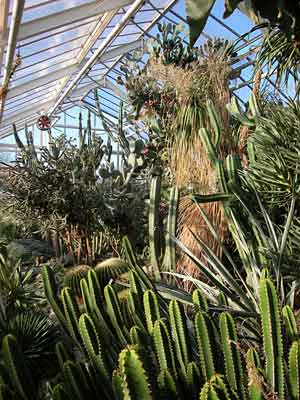
The cacti and succulents greenhouse.
|
Cacti and succulents are to be found in an additional greenhouse. Large and old cacti as well as euphorbia represent the main
hot arid regions of the Americas and Africa. A smaller section is dedicated to Madagascar. More cacti, succulents as well as carnivorous
plants can be found during the summer months in a display close to the observatory. The orangery protects many potted plants
from frost during the winter, while they are presented to the public around the ephemeral group during summer.
|







